| Release List | Reviews | Price Search | Shop | Newsletter | Forum | DVD Giveaways | Blu-Ray/ HD DVD | Advertise |
| Reviews & Columns |
|
Reviews DVD TV on DVD Blu-ray International DVDs Theatrical Reviews by Studio Video Games Features Collector Series DVDs Easter Egg Database Interviews DVD Talk TV DVD Talk Radio Feature Articles Columns Anime Talk DVD Savant HD Talk Horror DVDs Silent DVD
|
DVD Talk Forum |
|
|
| Resources |
|
DVD Price Search Customer Service #'s RCE Info Links |
|
Columns
|
 |
The Day of the Triffids |

|
The Day of the Triffids Not on (acceptable) DVD as of yet 1963 / Color / 2:35 CinemaScope / 93 min. Starring Howard Keel, Nicole Maurey, Janina Faye, Mervyn Johns, Carol Ann Ford Cinematography Ted Moore Art Direction Cedric Dawe Special Effects Wally Veevers Original Music Johnny Douglas, Ron Goodwin Written by Bernard Gordon (uncredited) from the novel by John Wyndham Produced by George Pitcher, Philip Yordan Directed by Steve Sekeley (and Freddie Francis) |
Savant has always loved The Day of the Triffids - there's something wonderfully real about the post-apocalyptic menace in John Wyndham's 1951 novel. Its intriguing concept has been attempted many times since on screen: civilization is stopped dead in its tracks by an unforseen event, and we get to pit our wits against monsters in a fight for survival. This 1962 film version is no classic in either script or execution, and yet its story is still irresistible.
Wildcat writer-producer Philip Yordan must have formed Security Films to spend money earned through screenwriting; in 1960 he was in Europe fashioning highly profitable blockbuster pictures for Samuel Bronston and other epic-makers. His version of The Day of the Triffids is something of a fascinating bust clearly doomed by bad production management. A potential epic is sidetracked by poor writing, as if Yordan just didn't have the energy or time to do it right -- blacklisted screenwriter Bernard Gordon apparently wrote a final screenplay that the tatty production couldn't fully get on film. Just the same, the big-scale CinemaScope show has its ardent fans.
No acceptable DVD or video version exists of this monster favorite, although a decent letterboxed laserdisc came out for a few weeks in 1990. An inferior "Cheesy Flicks" disc arrived in 2205, but it appears to be a bootleg of that old laserdisc: with a pale 2:35 flat letterbox transfer. So far the best way to see John Wyndham's story is through the 1981 BBC miniseries, but a restoration of the 1963 theatrical original is (slowly) on the way.
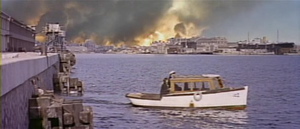
The novel The Day of the Triffids is a perennial favorite filmed only twice but forever being resurrected in spirit in post-apocalyptic movies. The original story makes sense in ways that the monster-oriented Steve Sekely film does not. Wyndham's original Triffids are already a daily reality before the meteorite shower that blinds most of the world; they are raised on controlled farms where their poisoned whips are carefully trimmed so that a fine oil useful in industry can be harvested. Bill Masen is a worker on one of these farms. Through an accident with an improperly docked (trimmed) Triffid he gets a mist of poison in his eyes. Bill's hospital stay makes him one of the fortunate people still able to see.
The book concentrates heavily on communal efforts to survive after the collapse of mankind. The Triffids are a side threat that becomes untenable as they increase in number. With a female companion named Josella, Masen allies with a couple of restrictive groups dedicated to caring for blind people; he finds their rigid rules difficult to take but cooperates. He then falls prey to another group that forces sighted people to help a certain number of the sightless to live by foraging for canned food. He escapes from that group and eventually seeks shelter on the farm of a relative. Survival there is possible until masses of Triffids lay siege to the farm house and armed representatives of yet another warlord community arrive to force Bill and Josella to take in dozens of dependents.
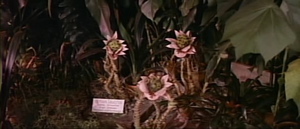
Barely mentioned is the origin of the Triffids, which Bill reveals near the end of the book. They were developed through genetic experiments in a lab, originally as a source of a fine oil for perfume. Spies stole a quantity of Triffid spores and were smuggling them by jet plane. The plane was shot down by competitors, releasing the spores into the stratosphere. The Triffids blanketed the Earth.
The film flattens out the Triffid concept into an obvious monster movie. The blinding meteors cause the Triffid spores, which arrived via an earlier meteor storm, to grow to maturity overnight. It plays as an extremely hokey coincidence, a convenient way of making the pesky Triffids into a deadly menace. In a world suddenly gone blind, almost anything could be a deadly menace - wild dogs ... anything.
The film script slowly reveals a world destroyed in a single night. Bill's eye surgeon kills himself upon realizing what has happened. Bill cannot help the people he finds staggering in the street. Trains run out of control and ships are left unguided. Unable to land, planes crash after they run out of fuel. All of this is rather literally depicted. With London in flames, Bill and his new friend Susan leave by boat to answer radio news of a conference in France.
The monsters aren't used very well. A Triffid in a greenhouse kills a night watchman and Bill sees one on the street. An encounter on a foggy country road is the best, simply for atmospherics - the hazier these monsters are, the better. Triffids come into play in France and later in Spain, massing by the dozens in the woods near Miss Durant's chateau and finally marching by the thousands against an electrified fence.
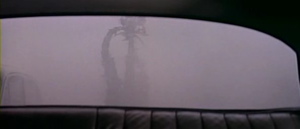
Somewhere in France, the production budget and script of The Day of the Triffids give out at roughly the same time. The book's ideas about groups competing in the post-disaster world are ignored. The invading soldiers are reinvented as freed French prisoners. The convicts invade Durant's school and force the women to sing, dance and drink with them, an elaborate but poorly-staged sequence. The story then shrinks in scale to just Bill, Susan and Miss Durant, who become a ready-made new family. Blind Bettina (Carol Ann Ford) tries to entice Bill into staying and helping at Durant's school, a gesture reminiscent of one group of scavengers in the book that tries to buy Bill's loyalty with a harem of willing, blind sex partners. A Triffid attack ruins any ideas Bill might have about becoming a post-apocalyptic Hugh Hefner.
Although rarely acknowledged, cataclysmic survival stories like The Day of the Triffids offer their audience an egocentric morbid fantasy based on survival. With few people left functioning and the law dissolved, we're free imagine ourselves among the lucky 'winners' given a chance to survive and prevail in a world operating under new rules. We can apply our own ruthless imaginations to the specific problems confronting the hero.
The movie's Triffids are never completely believable either standing still or in motion, and they never look as ferocious as the famous Ad Art (seen above and below, in yellow). Prop Triffids pulled by wires are exactly what they look like, clunky rubber mannikins that couldn't negotiate a step and never really seem alive. Their stalks are almost always tied together on top, probably because they'd fall apart otherwise. We see a stinger-whip in motion only once, and not too clearly. A couple of long shots use a model Triffid that moves far too smoothly. Later in the film we can tell that the walking plants are men in ill-fitting suits, shuffling along trying to look alive. Some angles are cut very short, but we can still see human legs stepping at the bottom of shots. If ever a movie concept needed Computer Generated Imagery, The Day of the Triffids is probably it.
The fact is that Wyndham's Triffids are a tough sell. The book's description doesn't make an individual plant sound particularly threatening. It's just a round bole at the bottom with three leaf-like feet that shuffle along like a one-legged man on crutches. The six or eight-foot stalk above just waves about wildly as the thing jerks forward. Triffids find something warm, sting it, and then sit on it 'til it rots, like fungus. They communicate by rattling dry, twig-like appendages. The movie at least gets that part right by providing a creepy sound effect.
The last section of the film is very bitty. Wally Veevers' special effects become desperate, with grainy mattes and smoke that disappears behind matte lines. The script simply goes away, leaving Keel and Maurey to exchange bare expository lines. Keel was quoted more than once as saying that the production just fell apart, and he had to make up his own dialogue. A married Castillian couple with terrible accents are glad to see the foreigners arrive to help deliver their baby. Expensive-looking but poorly filmed sets don't mesh well with real locations.
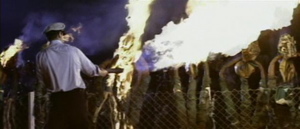
Apparently the script was so badly trimmed, when an assembly was made it was scarcely an hour long and lacked a conclusion - the little group simply gets picked up by a French submarine and is taken who-knows-where. Bernard Gordon explained that after a production hiatus, a second unit under director Freddie Francis was hired to put together new material. This accounts for the completely separate plotline taking place at a remote lighthouse besieged by the Triffids. Husband and wife acting team Kieron Moore and Janette Scott fret and struggle to keep the monsters out, a process broken into sections and intercut with the rather boring progress of Keel, Maurey and Faye. To provide a conventionally dramatic ending, Moore discovers at the last possible moment that sea water dissolves the Triffids into green soup. This hackneyed gag is treated as a "God saves humanity" scientific breakthrough. The solution makes no sense whatsoever. The Triffid monsters attacking the lighthouse matured on the rocks outside, which are constantly being soaked in sea spray.
I believe that the 1990 Image letterboxed laserdisc cost $50. Its quality was just okay but the disc finally let us see what the picture looked like in CinemaScope. Savant edited a version of the movie that omitted the entire added lighthouse subplot and bypassed the pitiful "jump off a rock, get picked up by a rowboat" ending. I just made a short montage of the massed Triffids surrounding the Spanish hacienda and repeated their clicking sounds to indicate that they weren't going away. Thus, my bogus cut of The Day of the Triffids ends like The Birds.
Savant still loves The Day of the Triffids and has been hoping for years for a decent DVD release. Triffids is not in the a Public Domain, but a low-budget video release in the early 1980s gave piratical distributors the illusion that it was, and bogus flat videotapes of awful quality turned up in various libraries, even legitimate ones. Whatever you do, take special care to avoid gray-market eyesores, which contain pale Pan-scan copies of the film. 1
October 29, 2005
Footnote:
1. The Day of the Triffids may indeed be surfacing in an excellent copy sooner than later - Savant has been informed that its original copyright has been verified and the negative is undergoing a painstaking restoration. I've also been told that new theatrical prints restore Ted Moore's color cinematography to its original luster. I'll report on the restoration further if I'm given permission - at the present time I've been asked not to say more. I certainly hope it all comes to pass as promised.
NOTE, October 20, 2006: One year later, I've only been told to be patient about progress on the film restoration of Triffids, which prompts me to suggest that nobody hold their breath. I know for a fact that the restoration is happening, but I no longer list it on a 'keep checking back' basis.
Added NOTE, October 31, 2009: Last night on Vine Street in Hollywood restorationist and friend Mike Hyatt screened a 35mm CinemaScope answer print of his photochemical restoration of The Day of the Triffids. This is the film that Mike has spent most of the last decade cleaning by hand, picking tens of thousands of tiny particles out of 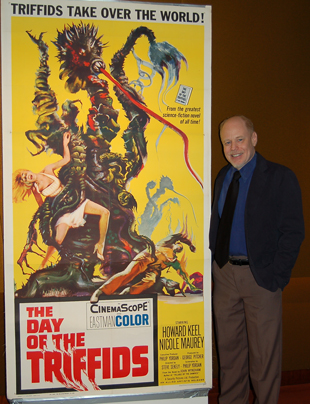 the soft emulsion of the original negative. What would have projected as a snowstorm of white flecks now looks pristine, clear, as if it were brand new.
the soft emulsion of the original negative. What would have projected as a snowstorm of white flecks now looks pristine, clear, as if it were brand new.
The title hasn't been seen in its original color and 'Scope since who-knows-when. Because Mike's original negative hasn't faded, we can see cameraman Ted Moore's cinematography for the first time and it's truly beautiful, with red and yellow highlights. When one character is killed by the walking plants, he's immediately struck a shade of Green. Before, I always thought the man's odd appearance was just a bad print.
Although technically the screening was a staff Halloween party for the Academy, Mike Hyatt invited a few guests to see the film on the Academy's big Pickford Center Linwood Dunn screen. The house was filled with friends and well-wishers who have been hearing about Mike's painstaking one-man restoration
Now Mike begins the digital restoration, cleaning up the film's title and optical sections where dirt and scratches are built-in, and have to be painted out. Mike Hyatt holds substantial rights to the picture and is hoping for an eventual DVD and Blu-ray release as well as making restored prints available for theatrical screenings.
Review Staff | About DVD Talk | Newsletter Subscribe | Join DVD Talk Forum
Copyright © DVDTalk.com All rights reserved | Privacy Policy | Terms of Use
|
| Release List | Reviews | Price Search | Shop | SUBSCRIBE | Forum | DVD Giveaways | Blu-Ray/ HD DVD | Advertise |





